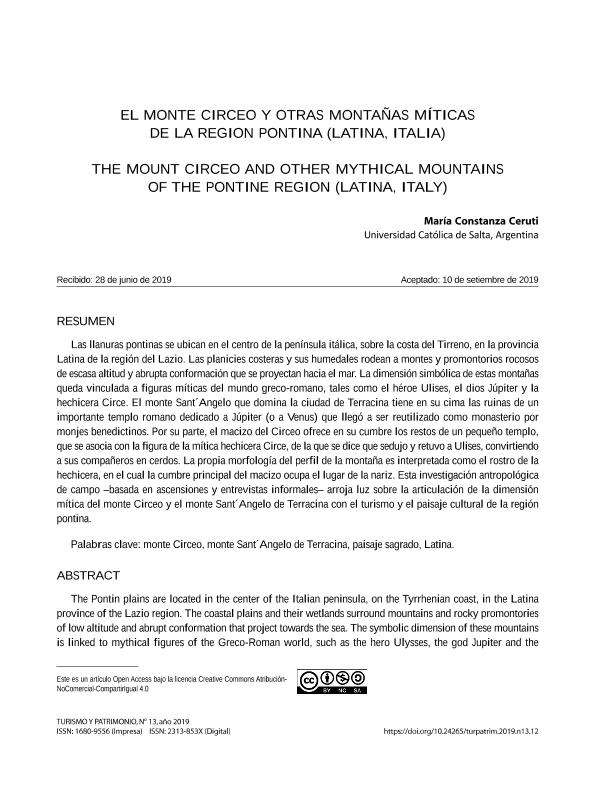Mostrar el registro sencillo del ítem
dc.contributor.author
Ceruti, Maria Constanza

dc.date.available
2020-11-09T18:47:21Z
dc.date.issued
2019-09
dc.identifier.citation
Ceruti, Maria Constanza; El Monte Circeo y otras montañas míticas de la región pontina (Latina, Italia); Universidad San Martín de Porres; Turismo y Patrimonio; 13; 9-2019; 177-189
dc.identifier.issn
2313-853X
dc.identifier.uri
http://hdl.handle.net/11336/117961
dc.description.abstract
Las llanuras pontinas se ubican en el centro de la península itálica, sobre la costa del Tirreno, en la provincia Latina de la región del Lazio. Las planicies costeras y sus humedales rodean a montes y promontorios rocosos de escasa altitud y abrupta conformación que se proyectan hacia el mar. La dimensión simbólica de estas montañas queda vinculada a figuras míticas del mundo greco-romano, tales como el héroe Ulises, el dios Júpiter y la hechicera Circe. El monte Sant´Angelo que domina la ciudad de Terracina tiene en su cima las ruinas de un importante templo romano dedicado a Júpiter (o a Venus) que llegó a ser reutilizado como monasterio por monjes benedictinos. Por su parte, el macizo del Circeo ofrece en su cumbre los restos de un pequeño templo, que se asocia con la figura de la mítica hechicera Circe, de la que se dice que sedujo y retuvo a Ulises, convirtiendo a sus compañeros en cerdos. La propia morfología del perfil de la montaña es interpretada como el rostro de la hechicera, en el cual la cumbre principal del macizo ocupa el lugar de la nariz. Esta investigación antropológica de campo –basada en ascensiones y entrevistas informales– arroja luz sobre la articulación de la dimensión mítica del monte Circeo y el monte Sant´Angelo de Terracina con el turismo y el paisaje cultural de la región pontina.
dc.description.abstract
The Pontin plains are located in the center of the Italian peninsula, on the Tyrrhenian coast, in the Latina province of the Lazio region. The coastal plains and their wetlands surround mountains and rocky promontories of low altitude and abrupt conformation that project towards the sea. The symbolic dimension of these mountains is linked to mythical figures of the Greco-Roman world, such as the hero Ulysses, the god Jupiter and the sorceress Circe. Mount Sant´ Angelo that dominates the city of Terracina has at its top the ruins of an important Roman temple dedicated to Jupiter (or Venus) that was reused as a monastery by Benedictine monks. For its part, the Circeo massif offers at its summit the remains of a small temple, which is associated with the figure of the mythical sorceress Circe, which is said to have seduced and retained Ulysses, turning his companions into pigs. The morphology of the mountain profile itself is interpreted as the face of the sorceress, in which the main peak of the massif occupies the place of the nose. This anthropological field research - based on ascents and informal interviews - sheds light on the articulation of the mythical dimension of Mount Circeo and Mount Sant’Angelo de Terracina with tourism and the cultural landscape of the Pontine region.
dc.format
application/pdf
dc.language.iso
spa
dc.publisher
Universidad San Martín de Porres
dc.rights
info:eu-repo/semantics/openAccess
dc.rights.uri
https://creativecommons.org/licenses/by-nc-sa/2.5/ar/
dc.subject
MONTE CIRCEO
dc.subject
MONTE SANT´ANGELO
dc.subject
PAISAJE SAGRADO
dc.subject
LATINA
dc.subject.classification
Otras Historia y Arqueología

dc.subject.classification
Historia y Arqueología

dc.subject.classification
HUMANIDADES

dc.title
El Monte Circeo y otras montañas míticas de la región pontina (Latina, Italia)
dc.title
The mount Circeo and other mythical mountains of the pontine region (Latina, Italy)
dc.type
info:eu-repo/semantics/article
dc.type
info:ar-repo/semantics/artículo
dc.type
info:eu-repo/semantics/publishedVersion
dc.date.updated
2020-05-27T17:09:24Z
dc.identifier.eissn
1680-9556
dc.journal.number
13
dc.journal.pagination
177-189
dc.journal.pais
Perú

dc.description.fil
Fil: Ceruti, Maria Constanza. Universidad Católica de Salta; Argentina. Consejo Nacional de Investigaciones Científicas y Técnicas. Centro Científico Tecnológico Conicet - Salta; Argentina
dc.journal.title
Turismo y Patrimonio
dc.relation.alternativeid
info:eu-repo/semantics/altIdentifier/doi/https://doi.org/10.24265/turpatrim.2019.n13.12
dc.relation.alternativeid
info:eu-repo/semantics/altIdentifier/url/https://dialnet.unirioja.es/servlet/articulo?codigo=7063543
dc.relation.alternativeid
info:eu-repo/semantics/altIdentifier/url/http://ojs.revistaturismoypatrimonio.com/index.php/typ/article/view/202
Archivos asociados
